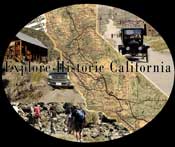 |
|
Knott's Berry Farm & Ghost Town ad from Desert
Magazine, May, 1961. Calico is featured in a story
by Lucile Weight, "Calico's Lively Ghost." |
Perched in hills
so multicolored that it reminded miners of the colorful calico cloth
popular in the 1800's, the town of the same name is easily seen
from Interstate 15, ten miles east of Barstow, California.
For many of us,
Calico Ghost Town, is the first and perhaps the only ghost town ever
visited. Declared California's official Silver Rush Ghost
Town, visitors can thank Walter Knott of Knott's Berry Farm fame,
for preserving Calico as a semi-ghost town/amusement park.
Seasoned ghost
towners may find it hard to put Calico in the same class as the
parched, rusty, and deteriorating remnants of the obscure mining
camps hidden on a dusty backcountry trail that they cherish
discovering on their own. However, many a school child and city
slicker can easily put together the "big mining picture" after a
visit to this one of a kind ghost town called Calico.
Silver
Discoveries
As early as 1875,
a man named Lee may have found the first silver ore in the Calico
Hills. The vein was so rich it was thought to be quicksilver.
Unfortunately Lee wandered away from his find and was believed to be
killed near Old Woman Springs by Indians. Later, a man named Porter
was operating a mill near the site of the town of Barstow. In the
fall of 1880 he relocated Lee's claims and the news spread like
wildfire. Hundreds of discoveries were made throughout the area. By
April 6, 1881, S. C. Warden, Hues Thomas, John C. King and friends
located the great Silver King Mine, which according to the first
issue of the Calico Print, was the was the "richest and biggest mine
in California."
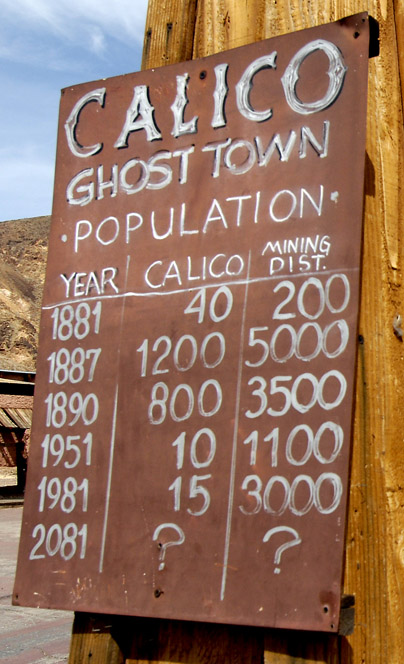 |
|
Chart in present day Calico shows town's boom-bust
cycles. |
Boomtown
Calico quickly
grew from a population of three men on July 4, 1881, and a solitary
cabin belonging to someone named Allison who had discovered the
Oriental Mine. Later that month, J. B. Whitfield and others claimed
the Burning Moscow Mine. The first mine to actually begin operations was the
Silver King Mine. By spring of 1882 one hundred people lived in
Calico. Most of them were ranchers who suddenly occupations. The Calico Townsite Company was formed and
town lots were sold.
There was talk of a narrow gauge railroad leading to Los Angeles.
In April of 1882,
a five stamp mill was in operation for the Burning Moscow. The Silver
King hauled ore 40 miles south along the Mojave River to the Oro
Grande Mining Company. The biggest problem for the mines was fuel,
as the groves of cottonwoods along the Mojave River provided the
only wood, and would soon be depleted.
In May of 1883,
miners fled to Mule Canyon east of Calico for borax. William T.
Coleman and company acquired many of the claims that were mined..
These failed by 1888, and were sold to F. M. "Borax" Smith and the
Pacific Coast Borax Company. That fall, a fire destroyed most of the
business section of Calico. With the mines producing big time, the
town was quickly rebuilt. The Calico Print described the town as
"now looking substantial, lively and prosperous, and we can safely
predict stirring times this fall and winter. Calico's colors are not
the kind that easily fade." Proving the newspaper statement true, a
second fire hit the town at a later date and Calico again rebuilt
continuing to thrive with a population that grew to 2,500 the
following year.
The Oro Grande
Mining Company
The Oro Grande
Mining Company consolidated several holdings in 1884. C. M. Sanger
from Milwaukee was the principal, D. Bahten, the superintendent.
Both the Oriental Mine and the Silver King Mine and Mill were
acquired, as well as many other properties. Another five stamps were
added to the mill. The Snow Bird in East Calico was added to the
company in 1885, and to the West Calico District came the Waterloo.
The Silver King was the best producer of all of the mines, with over
$1,000,000 in silver bars produced in a 14 month period. Miners
worked both day and night shifts every day of the week, including
Sundays. Wages were $3.50 for each nine hour shift. Unlike other
mining companies, employees of the Silver King were free to live
where they chose.
Tramways &
Railroads
Several tramways
for transporting ore, were built in Calico. The Mammoth built a 600
foot track, the Occidental was 1,000 feet., the Silver Odessa was
600 feet, and the Sue 300 feet. By March of 1885, the Oro Grande
Mining Company organized the Daggett and Calico Railroad Company
which would intersect the mines and mills and the town of Calico to
the Atlantic Pacific Railroad in Daggett. Surveys were made but no
work was done. In the meantime, The Calico Stage Line, and
Sheriff/teamster Joseph Le Cyr, provided primary sources of
transportation between Calico and Daggett.
In 1887, the Oro Grande
Mining Company's new 60 stamp mill burned to the ground not long
after it was built. As another mill was built in 1888, the company
finally built the narrow gauge railroad. It went from the Waterloo
mine tunnel to the stamp mill. By this time the town was waning, and
the Calico Print was no longer in production to record the event.
Ore and supplies were hauled back and forth on the train which was
pulled by two small saddle tank locomotives, the Emil and the
Daniel. Passengers choosing to ride with the ore and supplies were
allowed to stand in the ore cars holding on to the sides for support
during the bumpy ride.
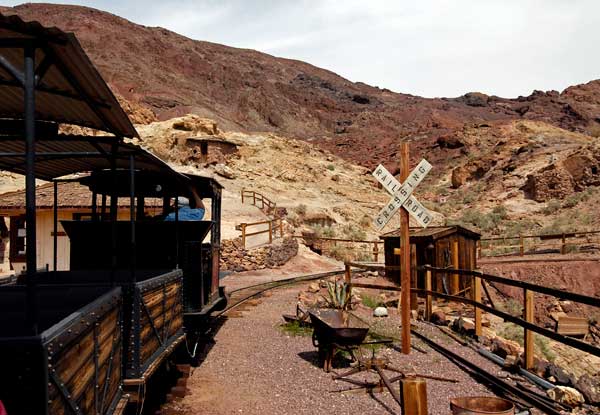 |
| The
Calico-Odessa Railroad takes visitors on a short, but
scenic ride through the townsite. |
|
 |
In February, 1889,
the Oro Grande Mining Company sold all its properties to the
Waterloo Mining company which was based out of Wisconsin. The Calico
Railroad, as it was often called, was part of the sale. The Waterloo
built a line to the ore bins at the Silver King Mine. By September,
1889, 100 tons of ore were transported daily from the Silver King
to the 75 stamp mill by the Mojave River. An additional 50 tons of
ore was hauled from the Waterloo Mine. In March, 1892, however,
dropping prices of silver closed the Waterloo. One hundred and
thirty men lost their jobs and the railroad closed as well. In 1896, the Silver King shutdown.
Calico was dying.
The narrow gauge railroad operated again
several years later. D. D. Connell and Marcus Pluth leased the Waterloo properties in May of 1899. In 1901, The American Borax Company constructed its
own
railroad. A mile of the Waterloo Mining Company's rails was kept in
use to join segments from the Columbia Mine to the plant in Daggett.
By 1903, all but that one mile section of the Calico Railroad was
taken up and the locomotives were sold to the American Borax Company
and to the Mojave Milltown Railroad.
A Ghost Town Is Born
Calico struggled
on with various companies leasing properties through 1941. During this time buildings were moved to the towns of Barstow,
Daggett, and Yermo. In 1915, a cyanide plant was built to recover
silver from the tailings of the mine dumps at the Silver King.
Walter and Cordelia Knott homesteaded at the nearby town of Newberry
during this time. Walter helped to construct the redwood cyanide
tanks at the plant. Later as the town of Calico faded, Knott kept an
eye on it. In 1951, as Knott became famous for his Buena Park berry
farm, he purchased Calico and restored it for modern generations to
enjoy as a ghost town, and amusement park. In 1966 Calico was
donated to San Bernardino County and is still operated as Calico Ghost Town
today.
Respectable
Mining Town
In the boom year
of 1886, the population of Calico was 1,200, with 50 of that number
school children. The town boasted a deputy sheriff, two constables,
a minister, two doctors, two lawyers, a justice of the peace and
five
commissioners. Church services were held in the town, and there was
a school, post office, Wells Fargo and Company express office,
telephone, telegraph, newspaper (The Calico Print), the usual
saloons, gambling parlors, and palaces of pleasures. By 1890, the
population swelled to 3,500 with its main street known as Wall
Street, containing many pink adobe buildings - boardinghouses,
restaurants, stores, assay offices, and combination shoe and boot
shop/bar. The emphasis in Calico was on hard work, honesty and
family values, without the traditional "man for breakfast" as so
many other mining towns were noted for.
|
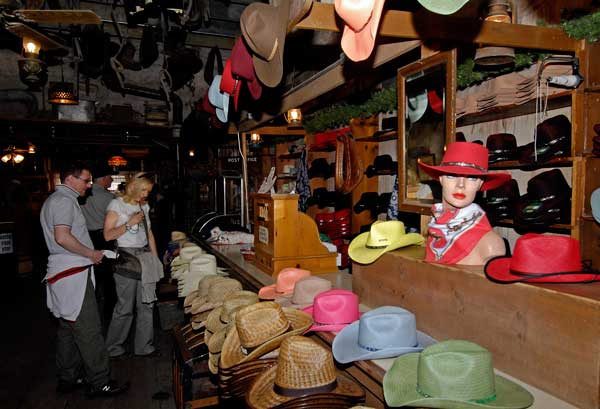 |
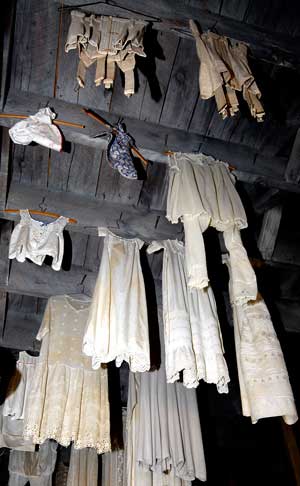 |
|
Visitors look over the hat selection (left) while
undergarments hang like ghostly apparitions in Lane's
General Store. |
Colorful
Characters
Calico did have
its share of colorful characters, and ruffians, even if it did not
boast the wild reputation of camps like Bodie, Darwin, and Cerro
Gordo. Only one homicide was recorded during the first two years of the town's existence. John Overshiner of the
Calico Print, was quoted as
saying "there are no more orderly and law abiding people living
anywhere than Calico."
Joe Joiner was
"the man about town" during Calico's heyday. Joe was a colorful
character who sported a swallow-tail coat and grew a long beard
which hung to his knees. His neighbors loved to play pranks on him.
They especially got a kick out of his long whiskers which he often
wore in braids or stuffed in his trousers to prevent them from
blowing in the hot desert winds. One evening Joe didn't make it home
from the saloon and fell asleep in the middle of Wall Street
instead. A Calico muleskinner described Joe Joiner as awaking the
next morning to find that the boys had cut off the "haw side" of his
beard and the "gee-tail" of his coat. This humiliated Joe so badly
he avoided Calico's main street from then on.
John Overshiner
came from San Diego to found the Calico Print, the town
newspaper. The Tombstone Epitaph heard the name chosen for the
paper and quipped, "the Calico Print smacked of petticoats."
John Overshiner simply replied, "It over shines a graveyard
inscription, anyhow."
Bill Harpold
owned the Hyena House, which was built out of barrel staves on the
outside and holes-in-the-rocks on the inside. As the Calico stage
would come in to town, Bill would stand outside with a wheel barrow
yelling, "Here y'are gentlemen, right this way for Hyena House, best
hotel in all Calico!" The "best" hotel in Calico was noted for
simple breakfasts of chili beans and whisky. After a storm caved in
the Hyena House, Bill dragged out his two guests and apologized for
the leaky roof.
Dorsey, a black
and white shepherd dog, delivered the mail from the post office in
Calico to the Bismarck Mines for three years. He was the only four-legged
mail carrier in the United States. Normally a friendly, playful dog,
Dorsey took his job of delivering the mail quite seriously. Anyone
daring to touch him was in trouble for tampering with the United
States mail. The Bismarck miner who owned Dorsey was once offered
$500 for him, but he replied that he would "sooner sell a grandson".
Town Ruffians
Town ruffians
caused a few problems in Calico. For entertainment, they would
often go to the east end of town and raid Chinatown. This went on
for a long time until the Chinese finally learned to defend
themselves using laundry paddles and hot irons. For an April Fool
joke, the ruffians stuffed a dummy and shot it full of holes,
penetrating most of the Calico community as they did so. It was
common practice to hold a gun in the air and just shoot it off for
fun. In 1885, one group of boys was caught driving stakes and
stretching wiring near the town, fencing in a lot. When told they
were not old enough to own real estate, one replied, "You bet we
can. If anybody tries to jump my lot, I'll shoot him!"
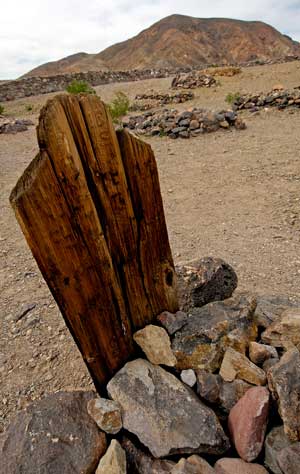 |
| The
Calico cemetery is the resting place for miners, ruffians
and just plain folk. |
A few disputes
were over mines. One day in 1885, just as men faced each other armed
with rifles and shotguns in an argument over the Occidental Mine,
the deputy sheriff arrived and persuaded them to settle the case in
court. That same year, at a May Day ball and ice cream and
strawberry festival in the town hall, the superintendent of the
Occidental Mine was called outside only to be bombarded by raw eggs
from uninvited guests of a rival mine.
Guns were drawn and fired by
superintendent James Patterson, and the attackers retreated. One man
ran into the town hall and interrupted the festival going on inside
with more shooting following him. The deputy sheriff arrived soon
after and the festival was over. Had this behavior happened on the
Fourth of July, the town might have tolerated it, but being as it
was May Day, the Calico Print declared the commotion a "disgraceful
and outrageous assault."
Red Light
District
Unlike other
mining towns, the red light district of Calico was right down the
middle of Calico's main street known as Wall Street. Apparently no one
had any problem with this arrangement, until some of the patrons of
the brothels found themselves being robbed. Most victims were too
embarrassed to admit they had been robbed while visiting the painted
ladies. Finally, one man demanded the perpetrators be brought to
justice. The owners and 16 employees were arrested for the
robberies. Prostitution was a perfectly acceptable practice in
Calico, but robbery was not. In 1885, however, the Justice of the
Peace had the working girls arrested. Calico's finest citizens stood
up for these girls, declaring they were receiving more
punishment than is due them, and a petition was presented to dismiss
the case.
Living
History
The sounds of
the stamp have been silenced in Calico, yet the music still
rings out from the dance halls and saloons, and shots from mock gun
battles still go on to the delight of the tourists who come to
experience a different sort of living history.
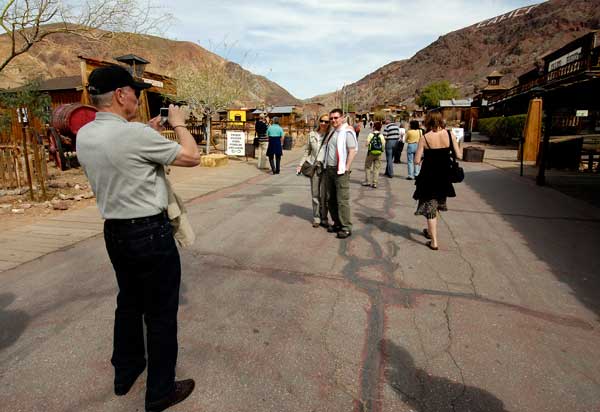 |
|
Tourists photograph themselves on the now paved streets
of Calico. |
As a baby
boomer, I can easily remember the feelings I had traveling to Calico
in the late 1950's and early 1960's. I grew up in the foothills of
the San Gabriels, and was well acquainted with the Angeles National
Forest, its manzanita bushes, and pine trees, and established forest
service camp grounds. The long dusty trip to Calico Ghost Town was
totally different than I was accustomed to. It seemed remote, out of
the way, scary. Even though it was winter when my family visited, I
was sure that a rattlesnake would crawl out of one of the old Calico
buildings and bite me bringing me to a painful death.
I remember it
being cold, and windy, and I could not think why in the world my
parents would want to bring me and my little brothers to such a
God-forsaken place. Yet somehow, in spite of my painful memories of
being in a place totally out of my element, I have visions of
touring the old silver mine, riding the little mining train, and
going for either a burro or mule ride. Between that and our more
than annual visits to Knott's Berry Farm, and its replica ghost town
which was my favorite part of the Buena Park amusement park, I had
somewhat of an idea of what a mining camp might have been like in
the 1800's.
As I grew
older I began to explore the real back country ghost towns and
mining camps. I have to say that between the books I have read, the
old pictures I have seen, my visits to remote places where perhaps a
tin can dump and part of a rock foundation, an old broken down stamp
mill, or even less than that were all that remained, I often find
that my memory of Calico, and Knott's Berry Farms Ghost Town, have
helped me realize how everything must have all come together in a
mining camp.
Bibliography
Ghost
Towns & Mining Camps of California
by
Remi Nadeau
Crest Publishing
Railroads of Nevada & Eastern California
Volume II: The Southern Roads
by
David F. Myrick
University of Nevada Press
Southern California's Best Ghost Towns
by
Phillip Varney
University of Oklahoma Press
The Silver Seekers-They Tamed California's Last Frontier
by
Remi Nadeau
Crest Publishers
Calico's Lively Ghost
by Lucille
Weight
Desert
Magazine, May, 1961 (pp 38-39)
|
